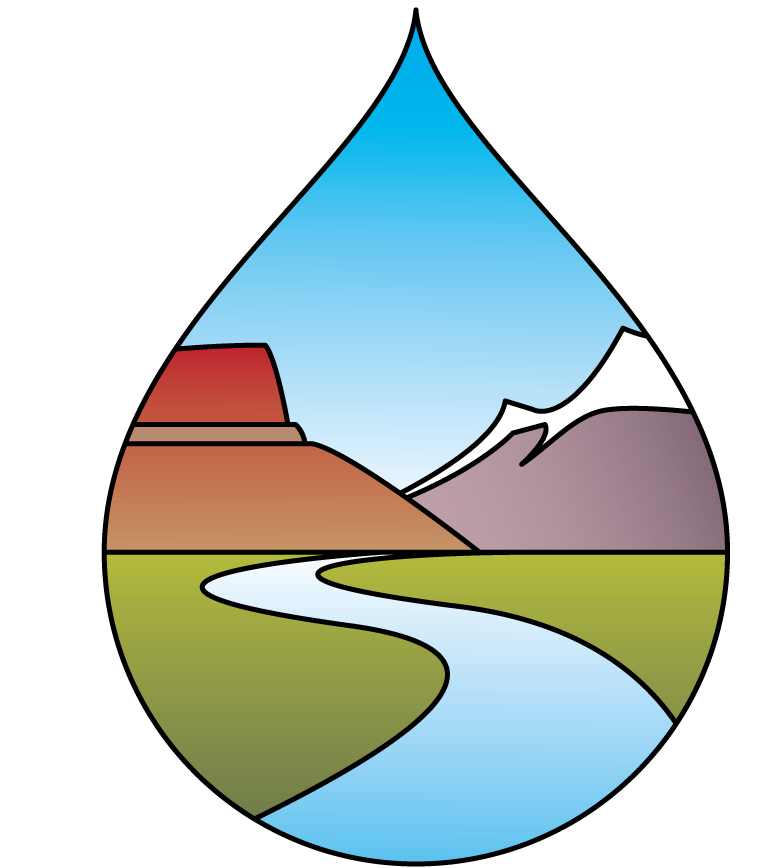Data Shared Through WaDE
Alaska is a member state of the WSWC
WADE Points of Contact
Water Rights

Access Alaska water rights data here
Water Use Data
Background
Agencies
The waters of Alaska are managed by two primary units within Alaska’s Department of Natural Resources, Division of Mining, Land & Water, Water Resources Section[1]. First, the Water Management Unit oversees the appropriation and the issuance of permits and authorizations for use of water in the state of Alaska, as per the Alaska Water Use Act, Alaska Statute Title 46 Chapter 16.15. This Unit also maintains the inputs to the Water Maps and Data Application, which allows users to access active and temporary water rights authorization in a spatial and tabular format. Information on locations of diversions and the acreage of irrigated area at the time of appropriation are also tracked. The second unit, the Alaska Hydrologic Survey (AHS), oversees the recording, evaluation, distribution and publication of water quantity, quality and locational information about Alaska’s waters as mandated by Alaska Statute Title 41 Chapter 41.08. This includes the collection and assembly of information on surface water flows and groundwater. More information about Alaska Water Use Data and Research (WUDR) is available online[2]. A presentation about Alaska Water Use Data System to the 2022 National Water Use Data Workshop is available online[3].
Surface Water
The Alaska Hydrologic Survey manages and stores its own stream gaging network, but has also funded USGS to maintain streamgages. The data from streamgages are used to estimate water availability in various basins and to support the Water Management Unit decision process. Water usage data is also stored and tracked by beneficial use on a site-specific, daily, monthly and/or annual basis, depending on when the permit holder is required to report. Some users are required to report diverted quantities or in some cases flows upstream of the diversion, and possibly the consumptive use, as specified in their water right. Alaska does not track instream flows, but has policies which allow water to be appropriated for this purpose[4]. Typically, diversions are not metered, with the exception of water allocated to power generation. Only users that have a reporting and metering requirement in their water right are required to do so. For other users, water use is not estimated. Some data cannot be shared (such as military installation use) for security purposes. The Alaska Water Resources Section issues water allocations, and tracks which have been adjudicated, the acres irrigated as specified in the water permit, and irrigation method used. They do not track the energy produced by water allocated to the thermoelectric sector, nor the energy facility and fuel type. Community water system populations are verified by another entity, the Alaska Department of Environmental Conservation.
Groundwater
Information from groundwater modeling is also incorporated into water budget estimates, Site-specific groundwater withdrawals are tracked by aquifer and beneficial use (as specified in the permit) on a daily or annual basis, as are the location of wells (some geographic coordinate, others by the PLSS). The Alaska Department of Natural Resources (ADNR), Alaska Hydrologic Survey (AHS), is a water-level data provider to the National Groundwater Monitoring Network (NGWMN)[5]. The ADNR collects groundwater data to evaluate changes in groundwater availability, the interaction between groundwater and surface-water, the response of groundwater systems to climate variability, and the effects of natural disturbances on groundwater levels.
The locations of injection wells and groundwater recharge areas were not historically tracked. There are no designated closed basins or special management areas at this time. Groundwater allocations and adjudication are tracked, as well as the acres irrigated at the time of the permit issuance. Irrigation method is also tracked, while energy produced by water allocated to the thermoelectric sector is not. Reporting requirements for groundwater users are similar to those for surface water. Users may be required to report both withdrawn quantities and consumptive use, as specified in a user’s permit. Public suppliers who use groundwater are metered, as well as some commercial uses.
Data Availability and Used Technology
The Alaska Water Use Data System (AKWUDS) was designed in 2016 to allow water right/authorization holders to submit monthly water use data online and to download data into an Excel file from AKWUDS database[6]. AKWUDS dataset includes both water rights’ permits and reported use. The Department of Natural Resources has an Open Data Portal for geospatial data such as surface water rights, groundwater well logs, based on ArcGIS [7]. A broader data access to Alaska land maps is available through an interactive access to State of Alaska land records through a web mapping application “Alaska Mapper[8].” The Alaska Mapper User Guide is web and mobile-based geographic information system (GIS) that allows users to locate Alaska land records information by navigating an interactive map of the state[9].
[1] Alaska Department of Natural Resources, Water Resources Program Website. (http://dnr.alaska.gov/mlw/water/)
[2]Alaska Water Use Data and Research (WUDR) Workplan https://www.usgs.gov/media/files/alaska-water-use-data-and-research-wudr-workplan
[3] Presentation about Alaska Water Use Data System:https://westernstateswater.org/wp-content/uploads/2022/02/02_Petrone_Alaska_2022_Water-Use-Data-Workshop_FINAL.pptx.pdf
[4] Alaska Department of Natural Resources. Factsheet: Reserving water for instream uses. (https://inletkeeper.org/wp-content/uploads/2017/10/instream-fact-sheet.pdf).
[5] The National Ground-Water Monitoring Network (NGWMN): https://cida.usgs.gov/ngwmn/
[6] Alaska Water Use Data System (AKWUDS) https://dnr.alaska.gov/akwuds/
[7] Department of Natural Resources Open Data Portal: https://data-soa-dnr.opendata.arcgis.com/search?tags=water%2Cpaad#
[8] Alaska Mapper: https://mapper.dnr.alaska.gov/
[9] Alaska Mapper User Guide https://storymaps.arcgis.com/stories/2aa5e30e05a14227a9eb2e18a3c5c3fe
